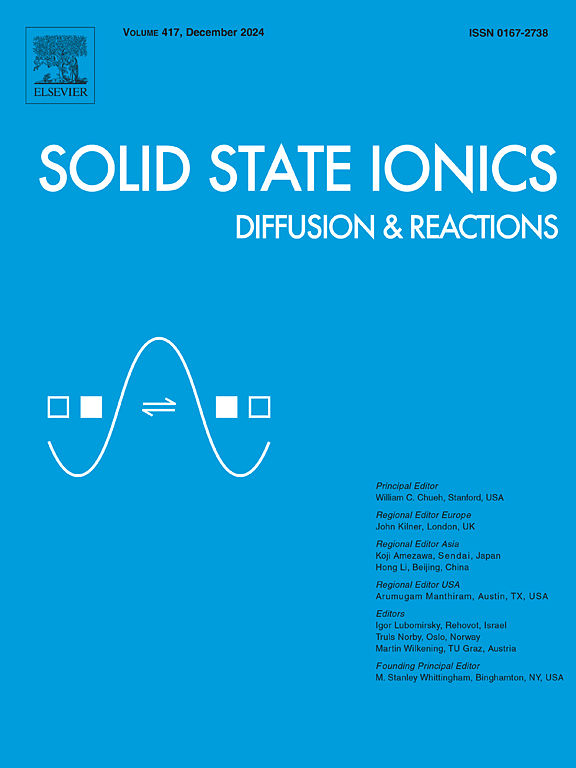Enhancing fluoride-ion conduction via doping-induced anionic ordering in an n = 1 Ba-based Ruddlesden-Popper oxyfluoride structure
IF 3
4区 材料科学
Q3 CHEMISTRY, PHYSICAL
引用次数: 0
Abstract
Tuning the atomic arrangement in mixed-anion compounds is one of the key research areas in solid-state chemistry, as it enables the understanding of the structure-property relationship. In this study, we proposed a strategy for fluorine ordering in an oxyfluoride compound with an n = 1 Ruddlesden-Popper (RP) structure, An+1BnO3n+1-xF2x, by aliovalent doping at the A-site. The framework structure based on Ba2(Sn/Zr)O4-xF2x was selected, because oxygen and fluorine occupy all three anion positions—equatorial, apical, and interstitial. To analyze the materials, we used a combination of high-resolution neutron diffraction, synchrotron X-ray diffraction, electrochemical testing, and computational analyses. Our findings show that doping potassium leads to fluorine ordering at the interstitial sites. This ordering occurs to balance the electronic charge at the anion positions, following the electrostatic valence rule. As a result, the electrochemical properties of the compound change: the electrical conductivity increases and the activation energy decreases. These results offer new insights and suggest a strategy for controlling the atomic arrangement in mixed-anion compounds, opening possibilities for designing materials with tailored properties.

在n = 1 ba基Ruddlesden-Popper氟化氧结构中掺杂诱导阴离子有序增强氟离子传导
调整混合阴离子化合物中的原子排列是固态化学的关键研究领域之一,因为它使人们能够理解结构-性质关系。在本研究中,我们提出了一种n = 1 Ruddlesden-Popper (RP)结构的含氟氧化合物an +1BnO3n+1- xf2x的氟有序策略,该策略通过在a位上掺杂共价来实现。之所以选择基于Ba2(Sn/Zr)O4-xF2x的骨架结构,是因为氧和氟占据了三个阴离子位置——赤道、根尖和间隙。为了分析材料,我们使用了高分辨率中子衍射,同步加速器x射线衍射,电化学测试和计算分析相结合的方法。我们的研究结果表明,掺杂钾导致氟在间隙位置有序。这种排序是为了平衡阴离子位置上的电子电荷,遵循静电价规则。因此,化合物的电化学性质发生了变化:电导率增加,活化能降低。这些结果提供了新的见解,并提出了一种控制混合阴离子化合物中原子排列的策略,为设计具有定制性能的材料提供了可能性。
本文章由计算机程序翻译,如有差异,请以英文原文为准。
求助全文
约1分钟内获得全文
求助全文
来源期刊

Solid State Ionics
物理-物理:凝聚态物理
CiteScore
6.10
自引率
3.10%
发文量
152
审稿时长
58 days
期刊介绍:
This interdisciplinary journal is devoted to the physics, chemistry and materials science of diffusion, mass transport, and reactivity of solids. The major part of each issue is devoted to articles on:
(i) physics and chemistry of defects in solids;
(ii) reactions in and on solids, e.g. intercalation, corrosion, oxidation, sintering;
(iii) ion transport measurements, mechanisms and theory;
(iv) solid state electrochemistry;
(v) ionically-electronically mixed conducting solids.
Related technological applications are also included, provided their characteristics are interpreted in terms of the basic solid state properties.
Review papers and relevant symposium proceedings are welcome.
 求助内容:
求助内容: 应助结果提醒方式:
应助结果提醒方式:


